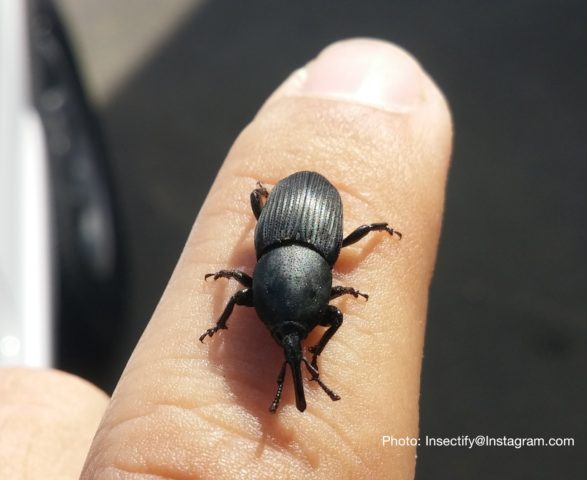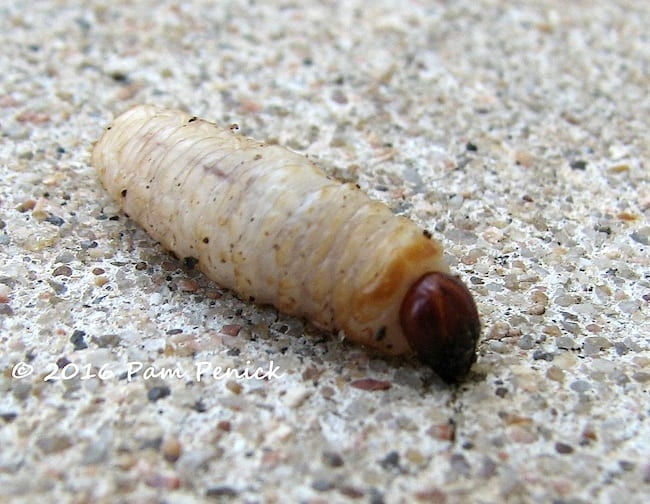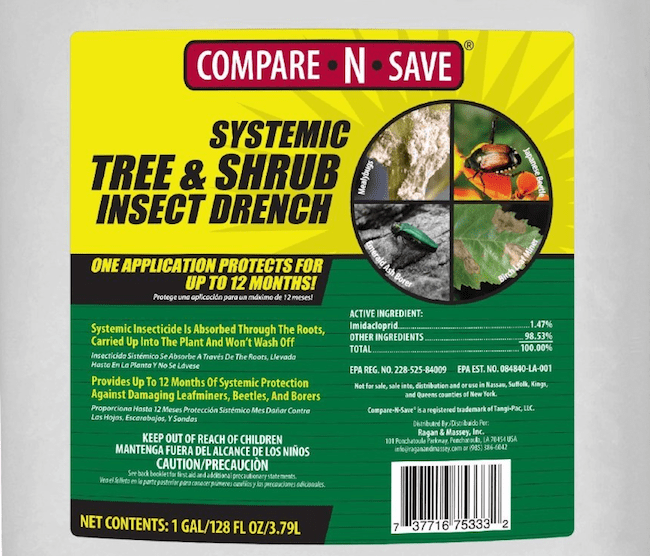
Agave snout weevil is a half-inch-long black beetle with a downward-curving proboscis that enables it to pierce an agave’s core, where it lays its eggs. Grubs hatch, consume the agave’s heart, then burrow into the soil to pupate. The weevil (Scyphophorus acupunctatus)—once prevalent only in desert regions and Mexico—is spreading rapidly throughout the US and abroad, earning it the dubious distinction of being one of the “Top 100 Worst Global Invasive Species.”

An agave’s grub-eaten core resembles a sponge.
According to the Global Invasive Species Database, “Scyphophorus acupunctatus is becoming a major pest of native Agavaceae and Dracaenaceae species worldwide. Native to Mexico, it has decimated populations of Agave crops there, in particular species used in the tequila and henequen industries. The importation of ornamental Agave plants worldwide has facilitated S. acupunctatus to establish in many parts of the world, particularly in Central America and the Caribbean, in Africa, Asia and South America.”
Is your agave infested? Look for damaged tissue where leaves meet stem. The lowest leaves will appear wilted, and may slope unnaturally downward while the center cone remains upright. The plant, no longer anchored by roots, will rock when pushed. When an infestation is well underway, it’s possible to push the agave over onto its side. It’ll break at soil level, revealing a mushy, foul-smelling core infested by plump, squirming, half-inch, cream-colored grubs with brown heads.

Nursery stock may be infested, so from now on, plant agaves bare-root.
Succulent collector Jeanne Meadow is well versed in pests that affect her plants. She has a large succulent garden in Fallbrook, California, halfway between Riverside and San Diego. Jeanne says people tend to assume nursery plants are pest free, yet that’s the main way snout weevil enters gardens. The beetles can’t fly.
When an agave in her garden shows signs of infestation, Jeanne removes it and every plant for several feet surrounding it. Then she sifts the soil and picks out grubs and beetles. “It’s a huge undertaking,” Jeanne says. “Fortunately they’re slow crawlers.”
Snout weevil hasn’t stopped Jeanne from bringing home new agaves. Before planting, she removes an agave from its nursery pot, sets the plant (root ball and all) in a wheelbarrow, and hoses the soil off the roots. She examines the plant for beetles and puncture holes, and the soil for grubs. If a plant is infested, she destroys it and informs the source nursery. Note: Jeanne plants ONLY bare-root agaves.
What about insecticides? Although neither Jeanne nor I advocate commercial insecticides, we agree that the responsible thing to do is to prevent the beetle from spreading. “This is an emergency situation,” Jeanne says. “The pest is spreading like crazy and has to be brought under control.” Pests of any kind, whether it’s rats, ants or mosquitos, need to be stopped as soon as they are seen, otherwise, the results could be disastrous. Luckily, pest control companies like https://www.futureservicesinc.com/pest-prevention/ offer pest prevention services so that your house doesn’t get a pest infestation. No one wants to deal with any sorts of pests in their home, especially as it can be a lot for anyone to deal with on their own. Saying this though, there is no harm in asking for a bit of help from a professional pest control olathe ks for example, to help get rid of the issues you are having with pests. The longer you leave it, this could potentially cause health issues. Plus, it is always best to be safe than sorry. You shouldn’t put this off, especially if you’re looking to take back your home after this unwanted infestation. Also, knowing that you could just search for something like terminix arkansas online, for example, there shouldn’t be any excuses why you can’t get in touch with a pest control company to finally get this sorted once and for all.
At the first sign of infestation, she drenches the soil around the agave with an insecticide that has Imidacloprid as the main ingredient. One brand, available on Amazon, is Compare-N-Save Systemic Tree and Shrub Insect Drench.
In my YouTube video, “Agave Snout Weevil Prevention and Treatment,” I demonstrate how to inspect nursery agaves, show resistant varieties, and interview agave expert Kelly Griffin at an infested colony of Agave americana.
Kelly mentions applying a systemic insecticide as a prophylactic (preventive) option. If you want to do this, it should be applied twice a year, in early and again in late spring, when the beetles are active. Systemics, as the name implies, spread insecticide through a plant’s system, so any bug that ingests it dies. This will indeed kill snout weevils and grubs, but won’t prevent the plant from being irreparably damaged, because…
It’s not the grubs that kill the plant by consuming its center core, it’s the bacteria that the weevil injects into the plant. The weevil is a vector (carrier) of Erwinia carotovora, a micro-organism that softens the tissues, so its grubs can easily consume it. After chewing into an agave that has been treated with a systemic, a beetle will likely die, but the insecticide won’t kill the bacteria the bug introduced. If your goal is to kill snout weevils before they spread, a systemic ought to do it. But if you have one or more agaves you want to protect at all costs, applying a systemic isn’t the answer.
Green alert: Insecticides kill beneficial insects too, and can disrupt your garden’s natural predator-prey balance. Birds and reptiles eat snout weevils, which have coexisted with agaves for millennia. Personally, I like the idea of my garden’s lizards feasting on the grubs, which look like meal worms sold in pet stores. However, even more, I like the idea of doing my part to prevent the beetle’s encroachment into residential succulent gardens. So, with reluctance, I’ll drench my agaves if and when I see a snout weevil in my garden, or even a hole indicating that the pest has arrived. And I suspect it will, because several large Agave americana ‘Marginata’ in my neighborhood have succumbed to the pest.
If you don’t want to use inorganic pesticides, remove an agave at first sign of infestation and don’t plant agaves in that part of your garden again. You might replace them with aloes, which are unaffected by the weevil. Btw, one organic control currently under development is a pheromone trap designed to attract adult beetles in search of mates. Weevil-resistant Agave varieties also are being selected and bred, but it may be years before a good supply is widely available.
Kibby Mayo of Oregon says she’s “found using Beneficial Nematodes to be effective in preventing and treating these infestations.” Basically, the nematodes kill insect larvae. I’d like to know if anyone in the Southwest has found it effective against weevil larvae. Worth a try.

Plant agaves only in pots. In areas where snout weevil is known to be active, plant agaves in containers, like the urns shown here. Potted agaves are more difficult for weevils (which don’t fly) to access, you can easily get rid of infested soil in case they do, and you know that the soil is OK in the first place because you put it there. Additional advantages to growing agaves in pots is that it elevates the plants for better viewing, enabling them to serve as garden focal points even when small. Moreover, potentially immense, pupping agaves (such as A. americana species) stay small in containers, which also serve to corral their offsets, preventing them from popping up elsewhere in the garden.
Susceptible and resistant succulents. The snout weevil seems to prefer Agave americana (especially older ones and variegates), but will go after other Agave species. It seems to stay away from agaves with soft leaves, such as Agave attenuata; those with tough, hard-to-pierce leaves (such as agaves ‘Sharkskin’ and victoriae-reginae); and those with slender, nonjuicy leaves such as A. bracteosa and A. filifera. However, it also infests other genera in the Agavaceae family, such as Nolina, Beaucarnea, Yucca, and Furcraea.
More info:
Pam Penick’s blog post: “Evil Weevils! Agaves Under Attack in Austin”
Tropical Texana blog: http://tropicaltexana.blogspot.com/p/agave-weevil-eradication.html
Desert Botanical Garden, Phoenix, AZ
Global Invasive Species Database
View my 7-minute YouTube video, “Agave Snout Weevil Prevention and Treatment.”

